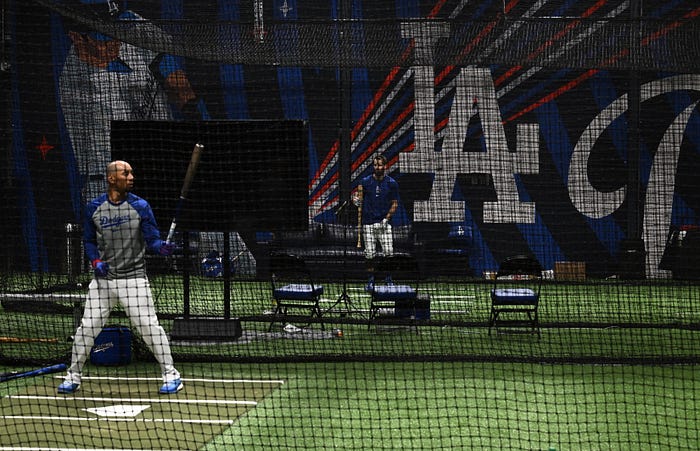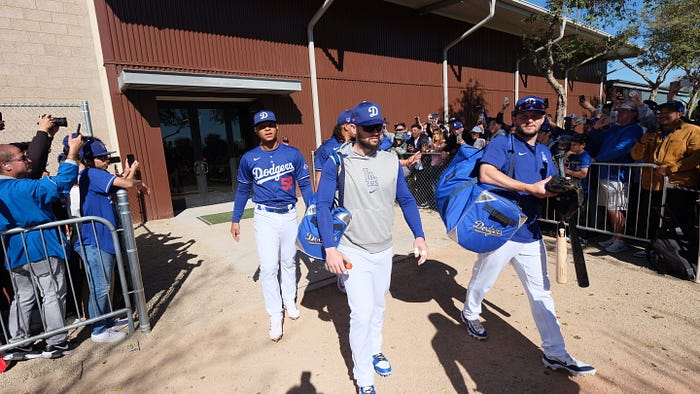Dodgers introduce players to their brand new lab
 Mookie Betts and Chris Taylor work out in the Dodgers’ performance innovation laboratory at Camelback Ranch. (Jon SooHoo/Los Angeles Dodgers)
Mookie Betts and Chris Taylor work out in the Dodgers’ performance innovation laboratory at Camelback Ranch. (Jon SooHoo/Los Angeles Dodgers)
by Cary Osborne
The Dodgers’ biggest offseason acquisition isn’t 6 feet, 4 inches tall. It’s 12,000 square feet.
It was a curiosity the first few days of Dodgers 2024 Spring Training camp at Camelback Ranch — a massive indoor facility on top of land once occupied by batting cages.
Players and coaches would introduce themselves generally by walking through the door of the big brown building and scanning the inside of the nearly three-story structure.
They saw batting cages, pitching machines, high-tech analytical equipment (such as motion tracking technology), office spaces and a skeleton wearing a lab coat peering in at them through a window.
The skeleton is an inside joke among the staff that runs the facility — a group mostly made up of individuals from STEM (science, technology, engineering, mathematics) fields.
Traffic increased throughout February to where the sounds of bats hitting baseballs, balls popping into gloves and analytical chatter became the norm at the Dodgers’ brand new performance innovation laboratory at Camelback Ranch (CBR).
The lab, a new addition to the Dodgers’ Spring Training campus, was a vision in 2016, as the organization saw how baseball, technology and sports science and performance were evolving and creating more objective ways to receive feedback.
Dodger players, coaches and staff showed up to Spring Training camp this year, and it was a reality.
“(The lab) is a collaborative effort to help target coaching and make players better and maximize their talents,” said Brandon Gomes, Dodger executive vice president and general manager. “The fact that we’re able to do this and do it at a high level, we’re really excited about it. We take pride in wanting to be trendsetters and at the forefront of the industry and taking on different initiatives or trying out ideas. And this will be another helpful step in doing that.” Dodger players make their way to the field through the team’s performance innovation laboratory. (Jon SooHoo/Los Angeles Dodgers)
Dodger players make their way to the field through the team’s performance innovation laboratory. (Jon SooHoo/Los Angeles Dodgers)
The lab is a year-round facility run by staff led by the Dodgers’ performance science group. It will benefit Major Leaguers during Spring Training, rehabbing in-season and during the offseason.
Injured Dodger players will often be sent to Camelback Ranch to receive more personalized treatment for injuries, and the lab allows players a place to train in a less occupied space than at Dodger Stadium.
The lab will benefit the Dodger player development group, as the introduction of draftees and international signees to the organization is often through Camelback Ranch, where many first play in the Rookie Arizona Complex League, and Minor Leaguers also first report to CBR for their own Spring Training.
For the staff at the performance innovation laboratory, the space and tools create an opportunity to implement data gathered from the previous year and track data going forward.
“Some of the data that we’re able to collect in-game (at Dodger Stadium), we’re mirroring here. So this gives us a great opportunity to kind of get a baseline on guys as they’re coming into Spring Training,” said Megan Schroeder, Dodger senior director of performance science. “What do they look like? How did that compare to what they looked like at the end of last season? Things like that. I think there are a lot of opportunities to kind of leverage what we are able to do here in Spring Training with our Major League team.”
Fitting in with the Dodger way, flexibility and collaboration have been two important words in the envisioning of the lab. Before the facility was built, a big piece of the conversation was a consideration of ever-evolving technology and the need to have the infrastructure in place to be equipped for the needs of today’s player, but also the flexibility for what comes tomorrow.
“We want to at least strive to be at the cutting edge of what technology is — either has been introduced into baseball or what’s coming next,” said David Hill, director of the performance innovation laboratory. “So we’re constantly trying out new types of tech and making sure that we have available the things that are already well established and staying true to what we do well, but then also trying to push boundaries and keep moving forward.”
A collaborative worked together to build the lab in less than a year — building began in April 2023 and the lab was occupied in January. Included in that group were Dodgers planning and development, Canopy Team, Dodgers IT, the team’s performance science group and research and development, architectural firm HKS and construction engineering company Mortenson.
Hill is part of the collaborative of 10 people who have taken the torch and are now creating an environment for players to get better, advance their knowledge and prevent injury.
Hill has a Ph.D. and master’s degree from the Massachusetts Institute of Technology and has a background as a research scientist and software developer. Schroeder has a Ph.D. in biomedical engineering from Northwestern University.
The makeup of the team includes people with mathematics, computer science and biomechanics backgrounds, and other areas of expertise — including baseball player development. Hill said having people with player development backgrounds is critical in bridging the gap from a language perspective between the STEM and baseball people.
Hill emphasizes that it’s not a one-way conversation either, as his team relies on the feedback from players and coaches to act on different thoughts and ideas — all in an effort to elevate Dodger players.
Over the last decade, the Dodgers have had a sterling reputation when it comes to developing Minor League players into Major Leaguers and being an organization where players from the outside come in and thrive.
The 2023 season was a perfect example of that with eight players making their Major League debut and veterans like Jason Heyward, Ryan Brasier and J.D. Martinez enjoying resurgent seasons.
The Dodgers’ active offseason brought in a large group of players that could potentially advance that reputation. The organization now has a facility to help foster that advancement.
“I think we are always proud of when players come in, and we identify some things that we feel can be improved to have that player take the next step,” Gomes said. “It’s certainly something that has been helpful in recruiting and players wanting to come here, knowing that our coaches in our group are just dedicated to pouring in resources to help that player be the best they can be. This should be another thing that allows us to continue down that path.”






































































